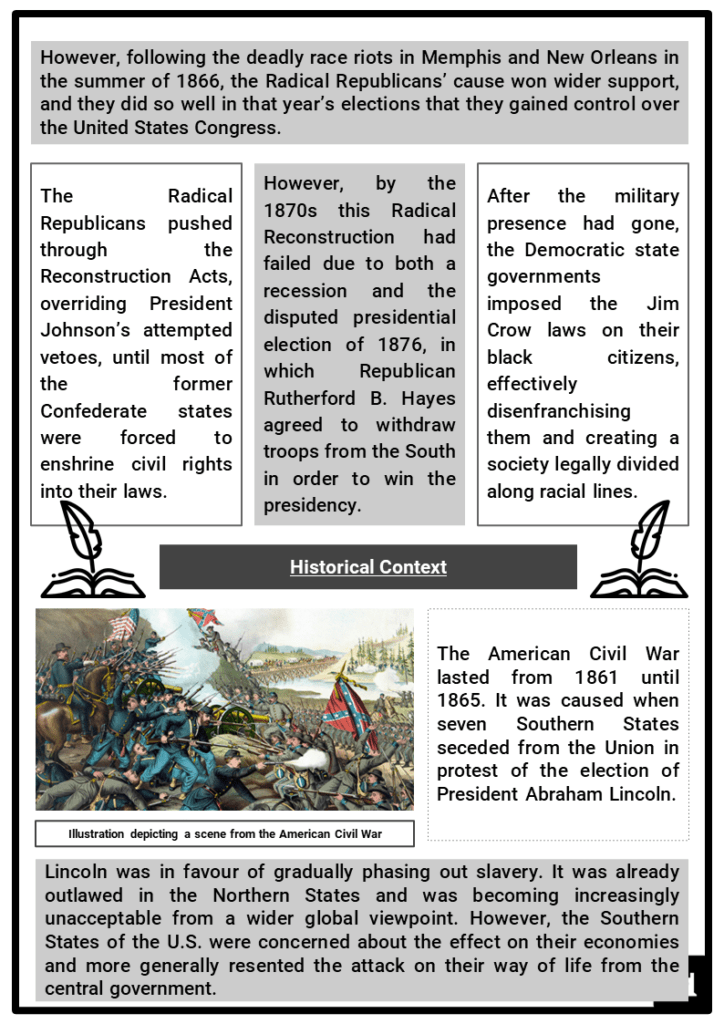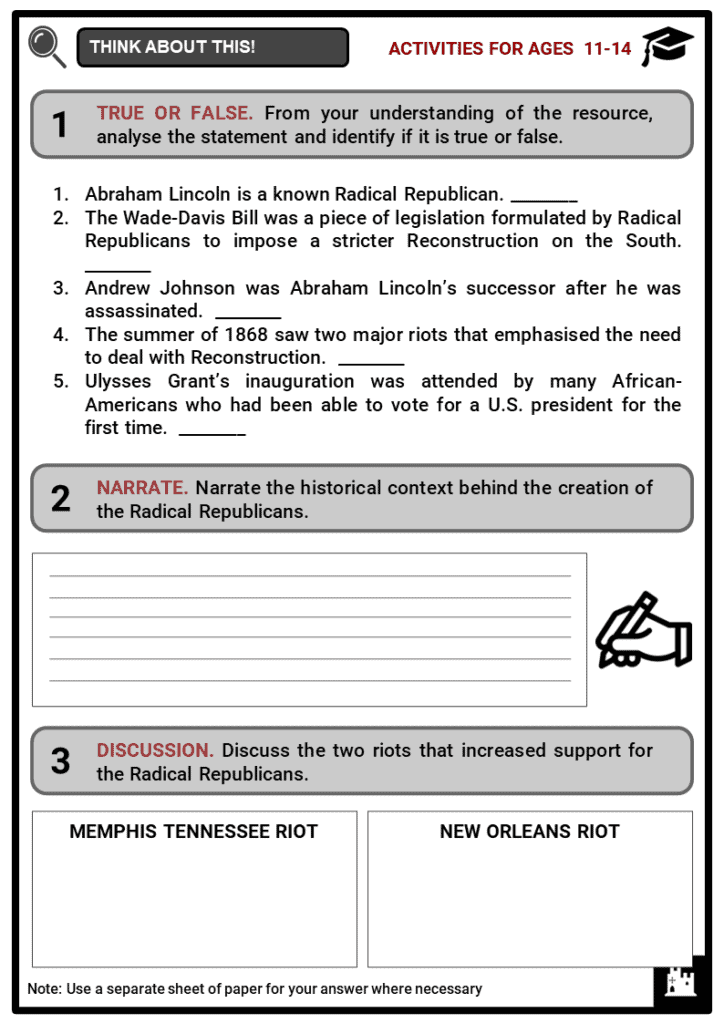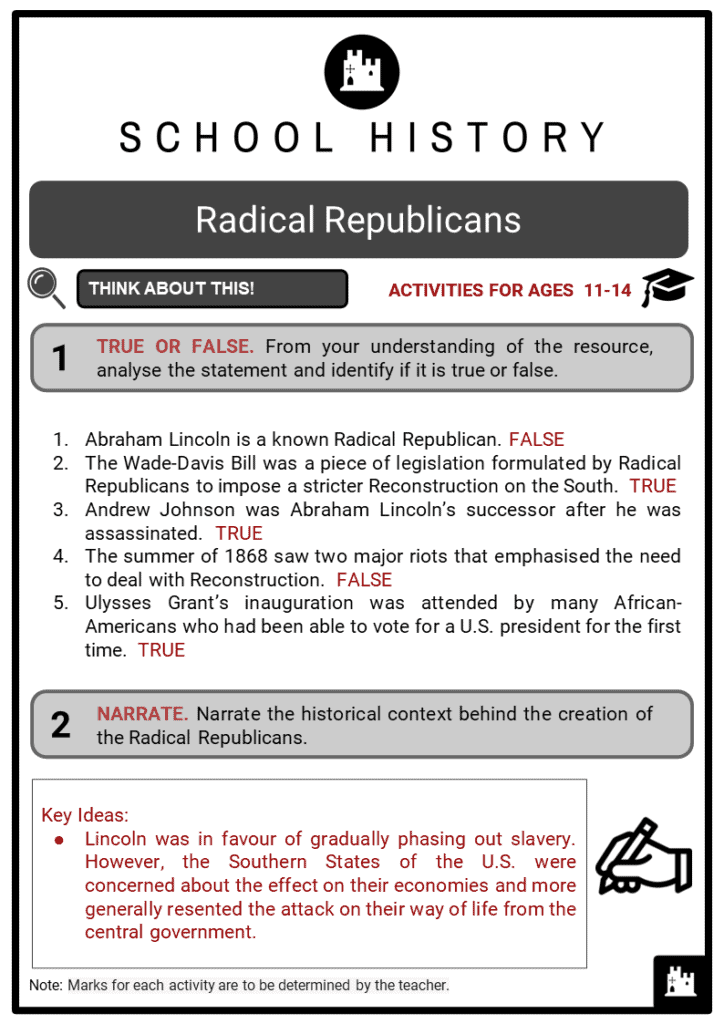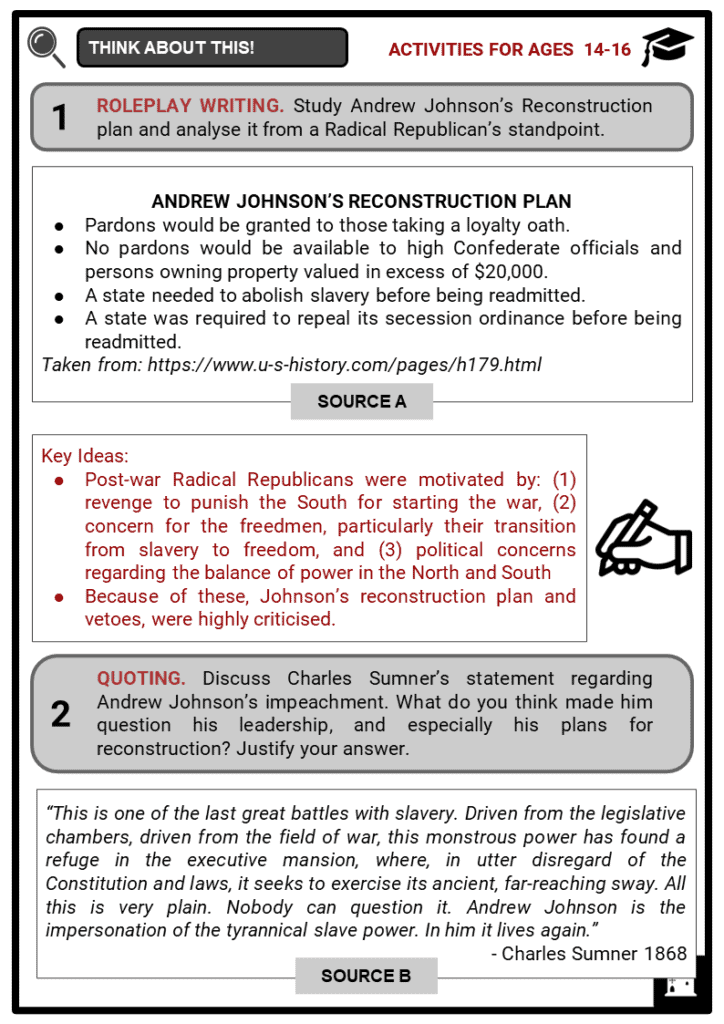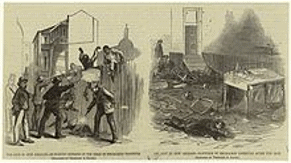Download Radical Republicans Worksheets
Do you want to save dozens of hours in time? Get your evenings and weekends back? Be able to teach Radical Republicans to your students?
Our worksheet bundle includes a fact file and printable worksheets and student activities. Perfect for both the classroom and homeschooling!
Table of Contents
Add a header to begin generating the table of contents
Summary
- The historical context behind the Radical Movement
- The Radical Movement
- The 1866 riots
- The role of Andrew Johnson and Ulysses Grant in the Radical Movement
- The end of the Radical Movement
Key Facts And Information
Let’s know more about Radical Republicans!
- Following the American Civil War, a faction emerged within the Republican Party that believed everybody in the United States, regardless of race, should have equal rights under the nation’s laws.
- They also thought that the states which had been part of the defeated Confederacy during the war should not be allowed to rejoin the Union unless they granted full rights to all freedmen, including the right to vote. This faction was called the Radical Republicans.
- The Radicals’ hard line stance on banning former Confederates from holding public office brought them into conflict with two successive presidents, Abraham Lincoln and Andrew Johnson.
- However, following the deadly race riots in Memphis and New Orleans in the summer of 1866, the Radical Republicans’ cause won wider support, and they did so well in that year’s elections that they gained control over the United States Congress.
- The Radical Republicans pushed through the Reconstruction Acts, overriding President Johnson’s attempted vetoes, until most of the former Confederate states were forced to enshrine civil rights into their laws.
- However, by the 1870s this Radical Reconstruction had failed due to both a recession and the disputed presidential election of 1876, in which Republican Rutherford B. Hayes agreed to withdraw troops from the South in order to win the presidency.
- After the military presence had gone, the Democratic state governments imposed the Jim Crow laws on their black citizens, effectively disenfranchising them and creating a society legally divided along racial lines.
Historical Context
- The American Civil War lasted from 1861 until 1865. It was caused when seven Southern States seceded from the Union in protest of the election of President Abraham Lincoln.
- Lincoln was in favour of gradually phasing out slavery. It was already outlawed in the Northern States and was becoming increasingly unacceptable from a wider global viewpoint. However, the Southern States of the U.S. were concerned about the effect on their economies and more generally resented the attack on their way of life from the central government.
- These Southern States formed the Confederacy, which was defeated by the Union after four years of bitter fighting. With the victory of the Union, slavery was abolished throughout the United States.
- However, there were now new problems that needed to be addressed. How should the freed slaves be treated in American society? And what action, if any, should be taken against the Southern States before they could be allowed to rejoin the Union?
- They also thought that leading Confederates should not be allowed to retain positions of power. However, many others, including the president, wanted to reintegrate the Southern States with minimal fuss and no further punishment for their actions.
- Politicians were bitterly divided on these issues. Many of those who had supported the abolition of slavery before the war believed that the freed slaves should have exactly the same rights as anyone else in the United States, including the right to vote (in the case of men only, since no women had the right to vote at this time).
- Directly following the Civil War, this period – during which the United States tried to work out how to move on from the terrible conflict – is known as Reconstruction.
The Movement
- The Radical Republicans were a group within the Republican Party who, following the abolition of slavery, believed in full citizenship for black people, including the right for black men to vote.
- They wanted the Southern States which had been part of the Confederacy during the Civil War to be forced to accept this before they were allowed to rejoin the United States and be part of the governing process again.
- Although they agreed on civil rights issues, the Radical Republicans were otherwise a diverse group which differed on matters such as the economy or labour.
- They did not have a leader as such, but notable Radicals included Thaddeus Stevens in the House of Representatives and Charles Sumner in the Senate.
- The president at the time of the Civil War, Abraham Lincoln, was a moderate Republican. He did not agree with the Radical Republicans’ belief that the Southern States should be forced to accept black suffrage and citizenship before they could return to the fold of the U.S. government.
- He even used his presidential veto to block the Wade-Davis Bill, a piece of legislation formulated by Radical Republicans and passed by both houses of Congress (the House of Representatives and the Senate) to impose a stricter Reconstruction on the South.
- This move angered the Radicals so much that they tried to prevent Lincoln from being nominated as the Republican candidate for the 1864 presidential election. When this failed, they formed a new political party, the Radical Democracy Party, fronted by their own candidate, John C. Frémont.
- However, Frémont withdrew before election day for fear of letting the Democrats win by splitting the Republican vote. The Democratic Party was dominant in the Confederate South and the Radicals did not believe they could be trusted when it came to abolition or the Union.
- In 1865, Abraham Lincoln was assassinated. His successor was Andrew Johnson. The Radical Republicans at first supported Johnson, believing him to be sympathetic to their cause, but it soon became apparent that he was going to pursue the same lenient Reconstruction as Lincoln had.
- In December 1865, the Joint Committee on Reconstruction was established in Congress to discuss what conditions should be imposed on the Southern States before they could start sending representatives to Washington again. The Committee was bipartisan but was heavily dominated by Radical Republicans. It intended to try and push through Reconstruction via Congress, without input from the president.
- Against this political backdrop, racial tensions were rising in the South. Without concrete guidance from the central government, the Southern States had introduced the so-called Black Codes which were laws restricting the civil rights of the newly freed slaves.
The Riots
- The summer of 1866 saw two major riots that shocked America and emphasised the need to deal with Reconstruction.
- The first was in Memphis, Tennessee, in May.
- A violent altercation between white police officers and black soldiers escalated. Even after the black soldiers were confined to barracks, a white mob rampaged through black neighbourhoods, killing and raping people, and burning down homes, churches, and schools. Only the declaration of martial law put a stop to the chaos, by which time around 50 black people had lost their lives.
- In July 1866 another riot broke out in New Orleans.
- A parade of people protesting the Black Codes was attacked by an armed white mob that included many former Confederate soldiers. Most of the protestors were unarmed. In the brutality that followed, dozens of black people were killed and many more wounded. Federal troops were called in to quell the violence.
The Roles of Johnson and Grant
- Support for the Radical Republicans increased due to the riots, and their candidates swept to victory in the Congressional elections at the end of 1866, despite President Johnson campaigning against them. They now had the power to push through their Reconstruction legislation.
- In March 1867, the first Reconstruction Act was passed which divided the former Confederate states into five military districts. The Radicals felt that military oversight was needed to ensure that the new laws were upheld.
- Three more Reconstruction Acts were passed between March 1867 and March 1868. The end result was that Southern States were to accept martial law, to introduce voting rights for black men, and to ratify the Fourteenth Amendment to the U.S. Constitution.
- This amendment would guarantee equality under the law for all citizens of the United States, regardless of race. President Johnson tried to use his veto on all the Reconstruction Acts, but Congress pushed the legislation through in spite of this.
- Another act that Johnson tried and failed to veto was the Tenure of Office Act, which restricted the president’s ability to dismiss certain officials. When Johnson tried to remove the Minister for War (Edwin M. Stanton, a Radical Republican), Congress decided that he had broken the law and voted to impeach him.
- If Johnson had been found guilty he would have been forced to step down as president, but he was acquitted in the Senate by just one vote in May 1868. However, after this he was a ‘lame duck’ president, i.e. no longer having any influence on policy.
- At the end of 1868, Ulysses S. Grant won the presidential election. Grant was sympathetic to Radical Republicans and his inauguration in March 1869 was attended by many African-Americans who had been able to vote for a U.S. president for the first time.
- He passed laws obliging states to allow black people to vote, and he also encouraged prosecutions of members of white supremacy organisations like the Ku Klux Klan and the Knights of the White Camellia. Since the end of the Civil War, these hate groups had been using intimidation and violence to stop black people from exercising their civil rights.
- By the time of the next presidential election in 1872, many politicians and voters felt that Reconstruction was complete and were no longer interested in it as an issue. Even Radical Republican Charles Sumner, who had fallen out with President Grant, joined the Liberal Republicans and campaigned against the president. Nevertheless, Grant was re-elected.
The End of the Movement
- The Radical movement was coming to an end, its agenda superseded by concerns about the economy, which had been hit by recession in 1873.
- In the Congressional elections of 1874, the Democrats took control. Southern State legislatures gradually reverted to the Democrats as well, and the reforms of the Radical Republicans began to be rolled back.
- In the highly controversial 1876 presidential election, Republican Rutherford B. Hayes managed to win power despite losing the popular vote, when he promised Southern States that all federal troops would be withdrawn.
- After this, civil rights were no longer enforced in the South, and the former Confederate states brought in the so-called Jim Crow laws.
- These laws allowed the segregation of white and black people, and although they did not explicitly state that black people could not vote, the conditions that had to be met in order to vote were disproportionately unfavourable to African-Americans. The inequality imposed by the Jim Crow laws persisted for almost a century.
Image sources:


